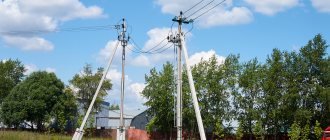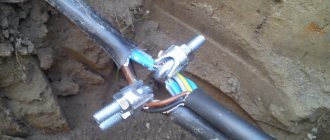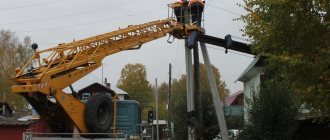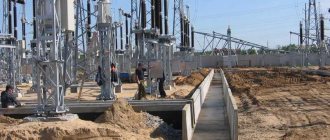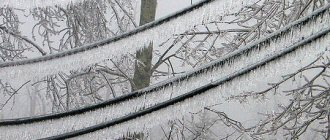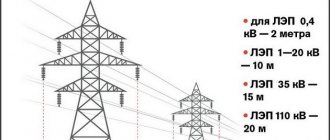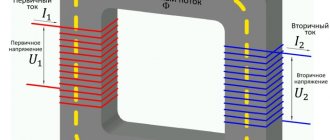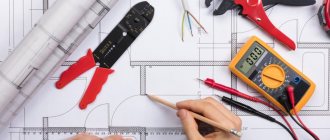Almost all owners of land plots through which overhead high-voltage lines pass are wondering about the restrictions associated with this. We have prepared an information collection that gives an idea of what the power transmission line security zone is and its main purposes. In addition, excerpts from regulatory documents will be given, indicating the burdens for users or owners of areas located along the route of overhead and underground power lines.
What is called the security zone of overhead power lines?
In essence, this is a conditional spatial corridor within which an overhead line (overhead line) is located. The height of the corridor is equal to the length of the power line support, and the width of the security zone is determined by the distance from two vertical projections from the external wires (h in Fig. 1).
Visual representation of the security zone
It is characteristic that the width of the power line zone, when it passes over the water surface, is greater than on land. The dimensions of security zones will be discussed in detail in the section on their boundaries.
Similar sanitary protection zones are provided for other electrical grid facilities, for example, electrical substations and underground power lines (cable power lines).
KLE security zone
Designations:
- H – Depth of the underground electric main.
- L – Distance from the electric main to the edge of the exclusion zone.
Moving cargo with multiple cranes
This is a complex operation that may also need to be performed near power lines. It can only be carried out under the direct supervision of the person responsible for the safety of cranes.
They also focus on the production design or technological map, which provides acceptable slinging schemes, cargo movement, applied safety measures and the procedure for carrying out work.
Important! Before work, it is necessary to calculate the load that will be placed on each crane. Naturally, it should not exceed the maximum permissible values.
It is recommended to use the same type of cranes and traverses. The main danger arises when loads are distributed unevenly between cranes. Uncoupling of the slings or swinging of the load may also occur, because the ropes are often in an inclined position.
Before work, each crane operator is instructed about the speed of lifting the load, the maximum height and the conventional signals that will be used.
Purpose of power transmission line security zones
The main goal of introducing such restrictions is to prevent direct and indirect factors of the negative impact of electric current on the human body. The first includes electric shock due to direct contact with an overhead line wire or from step voltage. When a wire breaks, the probability of such consequences is quite high, so an exclusion zone of certain dimensions is established for electric highways.
By indirect factors we mean the harmful effects of a high-tension electric field. Back in the last century, the involvement of electromagnetic radiation in the development of various pathologies in the human body was established. Those who live in the exclusion zone of power lines are more at risk of developing central nervous system dysfunctions, cardiovascular pathologies, disorders of neurohormonal regulation, etc.
As you move away from power lines, the intensity of electric fields in the protection zone decreases, and accordingly, their negative impact decreases.
Diagram of the propagation of electromagnetic radiation near a power line support with a voltage of 330-500 kV
Classification of protected areas with power lines
The following classification of security corridors has been adopted for the power grid system:
- Alienation of territory along overhead lines laid on land. The principle of differentiation was discussed above (see Fig. 1).
- Territories along underground cable lines (see Fig. 2).
- Alienation of space near underwater cable lines. The corridor is limited by vertical planes, conventionally located at a distance of 100.0 m on both sides of the cable, the water surface is considered the upper limit.
- Security corridors when crossing water power lines. In this case, the width of the corridor depends on whether the section of the water surface is navigable; if so, then the distance from the external cable to the border is 100.0 m. Otherwise, the width is calculated as for land.
- Radius of the security zone of transformer substations. The protective radius is set based on belonging to a certain voltage class; the ceiling is considered to be the highest point of the network facility.
Sanitary norms and rules for human activity and presence in the power line area
According to the rules of SNiP, a certain relationship has been established between the voltage class of power lines and the size of the security zone around the power line. In addition, sanitary rules clearly indicate what distance is considered acceptable between power lines and residential buildings or other economic facilities.
Safe distances are established in accordance with the power of the power line; according to sanitary standards, the permissible voltage level should not exceed 1.0 kV/m. Below is a table with current standards. The dependence of the exclusion zone on the power of the overhead line is clearly shown in the figure.
Safe distance from power lines, depending on the voltage class
In addition to sanitary standards, it is necessary to take into account the requirements of the PUE; it makes sense to consider them in detail.
Rigging and slinging work - safety measures when working near power lines
These types of work involve different situations, for which their own requirements and standards are prescribed. Let's look at them all separately.
Moving cargo with people on it and only people
Such movements are prohibited by the Rules for the Construction of Load-Lifting Cranes and Their Operation.
Manipulation can be carried out as an exception, when instructions are issued and approval is obtained from the Russian State Technical Supervision Authority.
In this case, only an overhead crane can be used and a cabin must be equipped that will ensure complete safety of people. Cabin safety requirements are developed separately.
Since overhead cranes are stationary (with limited movement), they are not used near power lines. This means that this manipulation is completely excluded in the situation under consideration.
Overhead crane
Moving loads over buildings with people inside
The movement of goods is prohibited above the ceilings of industrial, office and residential premises in which people may currently be present.
An event can be organized, but only after obtaining permission from the Gostekhnadzor authorities and developing appropriate measures to ensure the complete safety of people and property.
PUE requirements
The 7th edition (R. 2, Chapter 2.5) specifies the following standards:
- If a 0.4 kV - 1 kV overhead line is located parallel to the gas pipeline, then the distance between them must exceed the height of the electrical support. In cases where the pipelines intersect, an ungrounded protective canopy (screen) is installed over the gas pipeline, protecting the pipeline in the event of a power line break. The width of the screen should extend beyond the projection of the external power line by a distance depending on the voltage class:
- For overhead lines 20.0 kV - 3.0 meters.
- Overhead line 35.0 kV – 110.0 kV – 4.0 m.
- 150.0 kV – 4.50 m.
- 220.0 kV – 5.0 m.
- 330.0 kV – 6.0 m.
- 500 kV – 6.50 m.
- Since power lines can pass over certain types of non-residential buildings (workshops, warehouses, etc.), the distance between them and external overhead lines is considered safe in the following cases:
- 20.0 kV – at least 2 meters.
- 35.0-110.0 kV – from 4 m.
- 150.0 kV > 5.0 m.
- 220.0 kV and more – 6.0 m.
At the same time, there are restrictions according to which the construction of schools, kindergartens, sports grounds, and other facilities with large numbers of people is prohibited in the exclusion zones.
- Power lines are prohibited from running over residential buildings, the only exception being input lines.
- Between the power line and a parallel road, a distance of at least X+5 m is allowed, where X is the height of the electrical support. In cases where the lines cross a road belonging to the 1st category, the installation of anchor supports is required.
- If electric mains pass near technological facilities where explosive or flammable substances are stored or used (for example, gas stations), then the permissible distance is determined by one and a half height of the electric support.
- The height of the power line from the ground is determined by the voltage class of the latter and the type of terrain; the permissible distances are given below.
Permissible distances from wires to ground
Please note that in populated areas, the permissible distance from wires to ground has been increased. Detailed information about this can be found in the latest edition of the PUE.
What activities are prohibited?
In the exclusion zone, it is unacceptable to carry out actions that could disrupt the safe functioning of the network and cause the creation of emergency situations of varying degrees of complexity. These actions include:
- Throwing foreign objects onto overhead lines, as well as placing them on poles and supports of electrical networks.
- Erect buildings that block access to substations, poles or other electrical network facilities, or clutter the passage and access routes with various objects.
- Launch flying kites, drones or other aircraft.
- Enter inside the fenced area and power grid buildings (transformer or distribution substations, etc.).
- Make fires in the security zones of overhead lines, underground power lines or other electrical facilities.
Short circuit to ground due to a fire built under a power line. - Organize waste sites or landfills in exclusion zones, drain fuel and lubricants or caustic substances, and dump high-tonnage cargo.
- Use a trawl or drop an anchor near the underwater ELC.
- Passage of water transport with a deck superstructure or other mechanism exceeding the permissible size, etc.
It is prohibited to arrange a landfill in the security zone of power lines
Moving and lifting dangerous goods
Particular attention to compliance with safety precautions near power lines, and not only, must be shown when moving dangerous goods. These include substances, products and materials that have properties that, during movement, can, under certain conditions, lead to death, poisoning, injury, illness, radiation, fire, explosion, damage to equipment and buildings.
Delivery of dangerous goods
Only people who have undergone a preliminary medical examination are allowed to perform such work. Their health category must correspond to the nature of their activity.
All requirements are determined by state standards. Also, crane operators and other personnel undergo appropriate technical training.
After passing it, certification occurs. This class of workers must be trained to provide first aid.
Obtaining permission to carry out work
Here is a list of works for which it is necessary to obtain written permission to allow them to be carried out in the safety corridor:
- Carrying out any construction work.
- Changing the landscape, flooding, land reclamation or other terraformations.
- Felling forests, cutting down bushes or individual trees, including fruit trees, as well as planting them.
- Carrying out excavation work to a depth exceeding 30 cm or 45 cm on plowed soil (near underground cable lines).
- Dredging the bottom of reservoirs and fishing, including industrial fishing (in the protected zone of the underwater CLE).
- Passage of water transport if the distance between the power lines and the ship (at the highest point) is less than the permissible norm. In this case, it is necessary to take into account the load on the vessel, as well as the current water level.
- Passage of motor vehicles and special vehicles or transportation of oversized cargo under overhead lines, if the distance from the roadway to the highest point of the vehicle exceeds the established limits (usually 4.50 m).
If the vehicle height is more than 4.5 m, passage under power lines must be approved
Carrying out work in security zones and near power lines
Security zones along overhead power lines and above underground cable lines are installed to ensure the safety of electrical networks, reliable supply of electricity to industry and the population, and to prevent accidents with production personnel when performing construction, installation and other types of work.
The security zone along overhead power lines is a piece of land and space enclosed between vertical planes passing through parallel straight lines, spaced from the outermost wires at the following distances: for lines with voltage up to 1 kV - 2 m; from I to 20 kV - 20 m; 35 kV - 15 m; 110 kV - 20 m; 150...220 kV - 25 m; 500 kV - 30 m; 700 kV -40 m; 800 kV (direct current) - 30 m.
Under the term "close"
should be understood as carrying out construction, installation and other types of work, storing materials, arranging parking for machines and mechanisms at a distance closer than 30 m from the outermost wire of a power line or overhead electrical network with a voltage of more than 42V to the border of the security zone.
Organization of work using construction machines and mechanisms near (at a distance closer than 30 m from the outermost wire to the boundary of the security zone) power lines or overhead electrical networks with a voltage of more than 42V can only be carried out according to a permit that determines safe conditions for the work.
Work in the security zones of power lines or within the limits established by the Rules for the Protection of High-Voltage Electric Networks is permitted under a permit and only with written permission from the organization operating the power line.
Construction and installation work near and in the security zone of power transmission lines is permitted only under the direct supervision of an engineer and technical worker responsible for the safe execution of work in the presence of a permit and (in security zones) written permission from the organization that owns the line. The work order to start work in security zones and near power lines is issued by an engineer and technical worker (the person responsible for the electrical equipment of the organization), appointed by order of the organization. The work permit for work in security zones and near power lines is approved by the chief engineer of the construction and installation organization, after which it is signed by the responsible manager (foreman, foreman) and the responsible executive (foreman, team leader, senior worker). A work permit is issued for the period necessary to complete a given scope of work. In the event of a break in the work for more than a day, the work permit is canceled and a new one is issued when work is resumed.
Work using machines and mechanisms (cranes, excavators, etc.) is considered to be carried out in a security zone when any part of the machine or load during the work process may end up within the boundaries of the security zone. Work is carried out, as a rule, with the voltage completely removed from the power line. A necessary and sufficient condition for the absence of voltage on the power line during permission to work is the presence of portable grounding on the line wires at the work site (or at the nearest power line support). Disconnection of the power line, installation of portable grounding on the wires and registration of permission at the work site are carried out by the owner of the line. For work in security zones of power lines, a work project is drawn up with the development of specific measures to ensure the safety of work.
If it is impossible to remove the voltage from the power line and it is necessary to carry out construction and installation work in the security zone, the following requirements are observed:
installation, operation and movement of machines are permitted only under the guidance and continuous supervision of a responsible person appointed from among the engineering and technical workers of the organization performing the work, who has a safety qualification group of at least IV;
the person responsible for the safe performance of work on moving cargo by crane is obliged to provide instructions on safe work practices in the workplace with the crane operator, slinger and other workers included in the permit;
work using machines is permitted only if the air distance from the lifting or sliding part of the machine, as well as from the load being lifted in any position, including at the greatest lift or reach, to the nearest live wire is not less: up to 1 kV - 1.5 m; 1… 20 kV 2 m; 35... 110 kV - 4 m; 150...220 kV - 5 m; 330 kV -6 m; 500 kV - 9 m; 800 kV DC - 9 m;
The driver operating the lifting machine must have a safety qualification group of at least II, slingers - I;
lifting machines, except for crawler machines, must be grounded using a portable grounding device.
Operating machines directly under live overhead power lines of any voltage is prohibited. In addition, in order to avoid approaching an unacceptable distance to the wires, you should limit (if necessary) the angle of rotation of the lifting or retractable part of the lifting machine in the horizontal plane. The restriction must be carried out with a special locking device installed on the construction machine at the direction of the engineer and technical worker responsible for the safe performance of work in the security zone.
Only jib cranes are allowed to operate under the contact wires of urban electric transport, provided that the distance between the crane boom and the contact wires is at least 1 m when installing a limiter (stop) that does not allow this distance to be reduced when the boom is raised. The crane body must be grounded using a portable ground.
The passage of lifting and earth-moving mechanisms, as well as the transportation of building structures and equipment under live power transmission line wires, is permitted only if the vertical distance between the highest point of the moving mechanism or transported structure and the live wire is at least 2 m and for line voltages up to 20 kV, at least 3 m for line voltages of 35...110 kV and 5 m for line voltages of 330 kV.
When driving under a live line, the mechanisms are in the transport position. The movement of lifting and earth-moving machines off roads under live wires is carried out not in the place where the wires sag the most, but closer to the support. If it is impossible to maintain the specified distances, tension must be removed from the line while the mechanism is moving.
At night, work with lifting and earth-moving machines can be carried out only with the power lines turned off and with sufficient lighting of the workplace. When construction mechanisms and machines operate near power lines outside the security zone, grounding of the latter is not required. All work near power lines and in the security zone must be stopped, and people must be removed from the security zone in case of approaching and during a thunderstorm.
The security zone of electrical cable routes is the surface of the earth located above the underground cables plus 1 m on both sides from the outermost cables, and when cable lines pass in cities under sidewalks - 0.6 m towards buildings and structures and 1 m to the side roadway of the street. In the security zone of cable line routes, any excavation work (opening up earth covers, excavation work, etc.) that threatens the integrity of the cables without the consent of the organization operating these cables is prohibited. To carry out excavation work near and in the security zone of electrical cables, it is necessary to have an excavation warrant and a work permit signed by the chief engineer of the general contractor, who is fully responsible for compliance with safety requirements during the work. Permission to excavation work is carried out by a representative of the organization operating the cables, which is documented in an act with a sketch of the cable location on the back, and also subject to the following conditions:
the responsible producer of the work has a warrant to excavate and copy the layout of underground structures;
receiving from a representative of the operating organization a “warning” and an explanation on safety precautions, marking the boundaries of safe work;
carrying out, in the presence of a representative of the operating organization, control digging along the entire cable route on which excavation work is being carried out, with a distance between pits of no more than 10 m;
reliable protection by boxes and strengthening of exposed cables and couplings on a solid base in the horizontal direction;
entering a sketch of the cable location in the logbook of the earthmoving mechanism (without such a sketch in the logbook, work with the earthmoving mechanism is prohibited).
It is not permitted to expand the planned and agreed excavation area without additional approval from the organization operating the cables.
When digging, all cables with voltages over 1000V must be disconnected.
When performing work near and in protected areas of electrical cables, the following safety requirements are observed:
excavations are carried out only with shovels; the use of jackhammers for loosening and earth-moving machines for excavation is allowed only to a depth at which a layer of soil at least 0.4 m thick remains before the cables;
It is not allowed to carry out excavations with earthmoving machines at a distance closer than 1 m and to use a wedge at a distance closer than 5 m from the cables;
control pits are dug to the width of a shovel at a distance of at least 0.5 m from the proposed cable route, gradually approaching the cable until it is exposed;
exposed cables are not shifted or crossed;
if excavations are carried out at a depth greater than the depth of cable laying, and the cables are exposed for more than 1 m, then they are laid in pre-made boxes;
one of the walls of the box must be removable and secured without nails;
the use of adjacent cables, pipelines for hanging cables is prohibited.
Chapter 18

